Infrared thermometers give you instant, accurate temperature readings without contaminating your soap mixtures. You'll get safer measurements when working with lye solutions since there's no direct contact required. The digital precision helps maintain the vital 10-15°F temperature range between your oils and lye water, resulting in better soap quality and texture. Your soap-making process becomes more efficient with quick readings and fewer failed batches. Discover how this simple tool upgrade transforms your results.
Precision Benefits of Infrared Technology in Soap Making
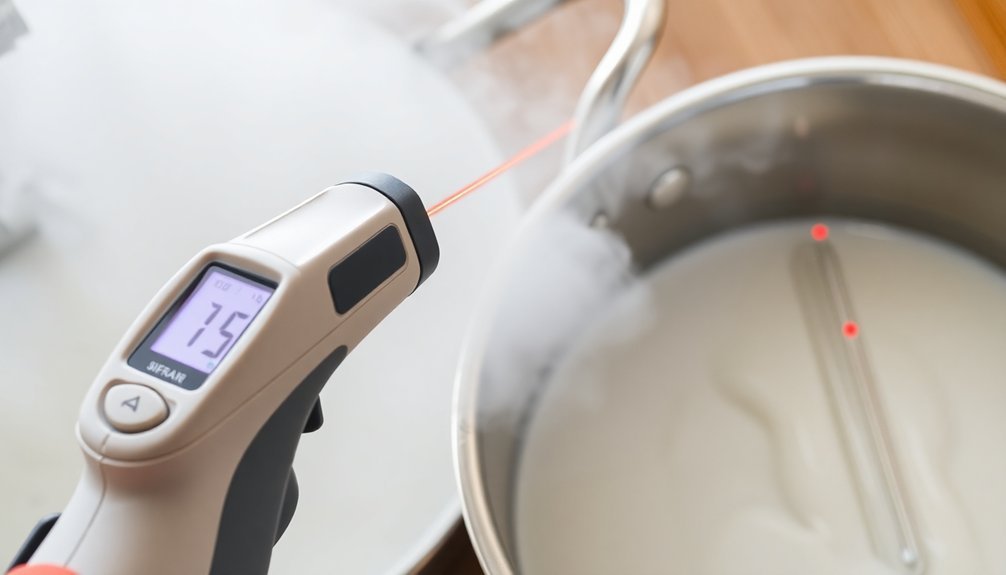
When crafting handmade soaps, precision in temperature measurement can make the difference between success and failure. Your infrared thermometer provides instant, accurate readings without contaminating your soap mixtures—a critical advantage during the sensitive saponification process.
You'll achieve superior results by ensuring your lye and oils fall within the ideal temperature range of 10-15°F. Infrared technology excels at monitoring these temperatures quickly, preventing overheating that could compromise your final product's quality.
Most modern infrared thermometers feature adjustable emissivity settings, allowing you to calibrate for different surface materials in your soap-making setup. This customization enhances measurement accuracy across various containers and ingredients.
Temperature Monitoring During Critical Saponification Phases
As your soap mixture undergoes the critical saponification phase, maintaining proper temperature control becomes essential for product success. Infrared thermometers provide instant readings of surface temperatures, ensuring your lye water and oils remain within the vital 10-15°F range of each other.
When measuring the temperature during saponification, you'll appreciate the non-contact feature that prevents cross-contamination between your ingredients. This technology allows you to quickly assess both mixtures without interrupting your workflow or risking burns from hot substances.
The accuracy and consistency provided by infrared readings directly impact your soap's final texture and quality. By monitoring temperatures precisely during this fast-paced phase, you'll prevent common issues like overheating or failure to reach trace—ultimately producing soap with the desired properties and consistency every time.
Non-Contact Advantages for Maintaining Soap Consistency
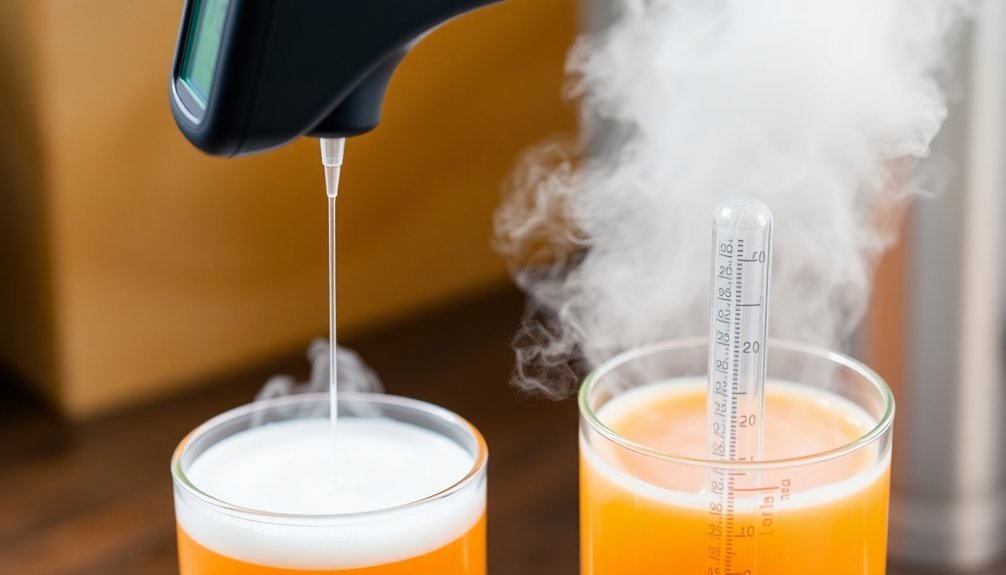
Non-contact infrared thermometers protect your soap batches from contamination while delivering instant temperature readings without disturbing your carefully crafted mixtures.
You'll appreciate how these devices let you quickly scan different areas of your soap, ensuring uniform temperature distribution throughout the entire batch.
This temperature consistency is key to predictable saponification, helping you produce soaps with reliable texture and quality every time.
Minimizing Contamination Risk
Because traditional thermometers require direct contact with soap ingredients, they can introduce unwanted contaminants into your batch. When you use infrared thermometers, you'll measure the temperature without touching the mixture, eliminating this risk entirely.
| Contamination Source | Traditional Thermometer | Infrared Solution |
|---|---|---|
| Bacteria from hands | Direct transfer possible | Non-contact prevents transfer |
| Residue from previous batches | Can cross-contaminate | No physical contact needed |
| Lye solution exposure | Requires dipping tool | Safe distance measurement |
Your infrared device creates a protective barrier between you and potentially caustic ingredients. This non-contact temperature measurement technique guarantees each batch remains pristine and uncontaminated, leading to more consistent saponification. You'll also maintain a cleaner workspace without the drips and spills that occur when repeatedly inserting traditional thermometers into different solutions.
Fast Precision Results
While traditional thermometers require time to stabilize, infrared thermometers deliver instantaneous temperature readings with exceptional accuracy.
You'll appreciate the fast response when monitoring critical soap-making phases, allowing you to make quick adjustments before your mixtures reach undesirable temperature thresholds.
The adjustable emissivity settings on quality infrared thermometers enable you to fine-tune measurements based on the specific materials in your soap recipe.
This customization guarantees consistent results across different batches, whether you're working with clear glycerin bases or opaque oil mixtures.
You can continuously check temperatures throughout your process without disrupting the mixture or waiting for readings to stabilize.
This efficiency not only saves time but also helps maintain the precision necessary for creating professional-quality soap with predictable characteristics every time.
Batch Temperature Uniformity
Maintaining perfect batch temperature uniformity stands as a hallmark of professional soap making, and infrared thermometers excel precisely in this area. With their high emissivity ratings, you'll accurately measure surface temperature across various soap textures, guaranteeing consistent readings throughout your batch.
Unlike contact thermometers that risk disturbing your mixture, infrared thermometers allow you to monitor multiple points without disrupting the saponification process. You'll quickly detect hot spots or cooling edges that could compromise your soap's quality.
The distance-to-spot ratio lets you safely check temperatures from afar, minimizing contamination risks and preventing dangerous lye burns. When you need to maintain ideal temperature ranges, you can instantly scan your entire batch, making immediate adjustments as needed.
This all-encompassing monitoring guarantees every portion of your soap develops consistently, yielding professional-quality results.
Comparing Temperature Range Capabilities Between Measurement Tools
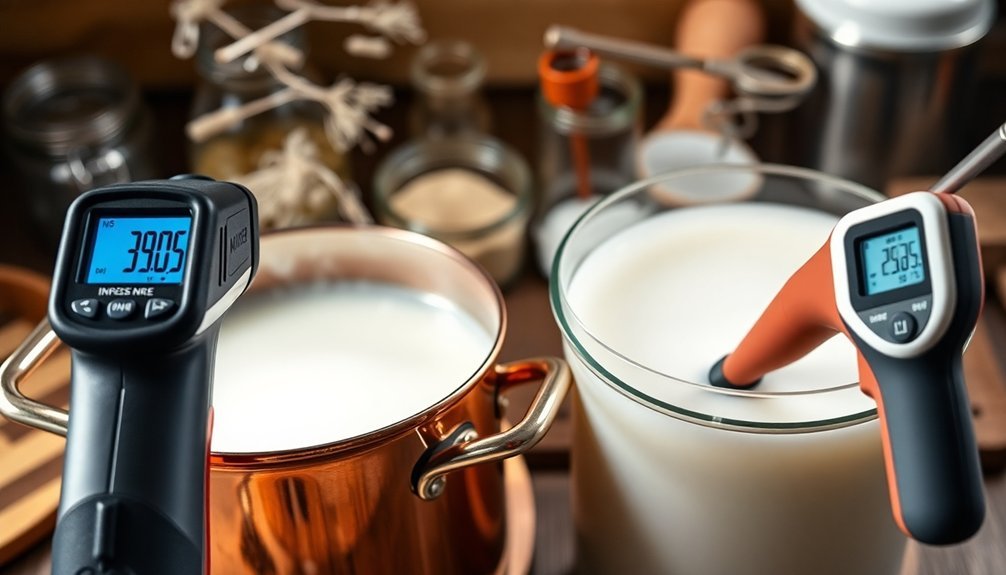
Infrared thermometers outperform traditional tools with their impressive -58°F to 572°F range, giving you complete coverage for all soap-making processes from cold mixes to hot oils.
You'll find digital thermometers offer better precision at mid-range temperatures while infrared excels at both extremes, essential when you're working with temperature-sensitive ingredients.
When choosing between analog and digital options, consider that analog thermometers might fail at extreme temperatures where digital and infrared alternatives maintain accuracy, ensuring your soap recipes achieve consistent results every time.
Temperature Range Extremes
When selecting a temperature measurement tool for soap making, understanding the range capabilities becomes crucial for handling both extreme highs and lows.
Infrared thermometers offer superior versatility with their extensive temperature range of -58°F to 999°F, while traditional thermometers typically max out around 400°F.
This difference matters in your soap making process for several reasons:
- You'll safely measure oils and bases at their highest melting points without risking damage to your equipment.
- The infrared thermometer's instantaneous readings help prevent burns when working with extreme temperatures.
- You can target specific measurement areas from a safe distance without contact.
- Adjustable emissivity settings promote accuracy across different surface types, from shiny oils to opaque soap mixtures.
Precision At Different Ranges
Although all soap-making thermometers serve the same basic function, their precision levels vary dramatically across different temperature ranges. When you're crafting soap, these differences matter greatly.
Infrared thermometers offer exceptional precision across a vast temperature range (-58°F to 986°F), which covers all soap-making processes from cool oils to hot pour stages. You'll get instant readings accurate to within ±2°C, without waiting for stabilization.
Traditional thermometers often fall short when temperatures climb above certain thresholds, compromising your results. They also lack the adjustable emissivity settings that infrared models provide, which allow you to calibrate for different surfaces like oils, waxes, and soap bases.
For consistently professional results, you need measurement tools that maintain their precision throughout the entire soap-making temperature spectrum—something infrared thermometers deliver that standard options cannot.
Digital Vs. Analog Capabilities
The battle between digital and analog thermometers centers on their fundamental temperature range capabilities, which directly impact your soap-making success. When selecting between options, consider these significant differences:
- Temperature Range – Digital thermometers like the ThermoPro TP03 offer an extensive range (-58°F to 572°F), while analog models often provide more limited spans for monitoring internal temperature.
- Response Time – Digital and infrared thermometer options deliver near-instant readings, allowing you to catch critical temperature changes quickly.
- Precision Control – Digital infrared thermometers feature adjustable emissivity settings that guarantee accuracy across different soap surfaces and ingredients.
- User Experience – Unlike analog thermometers requiring manual calibration, digital options provide consistent readings with minimal intervention, making sure you're always working within the proper range for ideal soap formulation.
Safety Considerations for Lye-Based Formula Temperature Checks
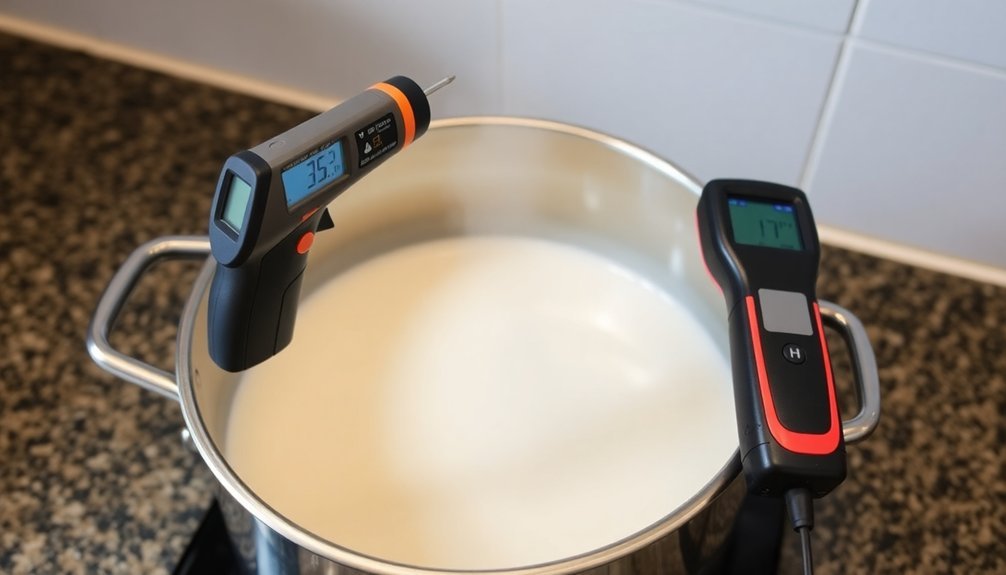
Handling lye requires meticulous attention to temperature monitoring for both safety and successful soap production.
When working with caustic substances, your infrared thermometer provides a significant safety advantage—you can check temperatures without risking direct contact with potentially hazardous materials.
You'll need to maintain your lye water and oils within 10-15°F of each other for ideal saponification.
An infrared thermometer allows you to perform these checks while wearing protective gear, eliminating the risk of splashes or burns that might occur with traditional thermometers.
This non-contact method prevents heat buildup near the measurement point, ensuring more accurate readings.
You'll also avoid dangerous scenarios where exceeding safe temperature ranges could make your lye volatile—a safety feature that's particularly valuable when introducing beginners to soap-making techniques.
Efficiency of Real-Time Temperature Assessment in Batch Production
When producing soap in larger quantities, efficiency becomes the driving factor in your operation's success. Infrared thermometers transform your production workflow by enabling real-time temperature assessments without interrupting the process.
- You'll achieve efficient monitoring across multiple batches simultaneously, allowing you to maintain consistent quality while increasing production volume.
- Your readings appear within seconds, eliminating downtime and keeping your operation flowing smoothly even in fluctuating ambient temperatures.
- You can quickly scan different areas of your soap batches to identify temperature variations that might affect quality.
- Your production timeline accelerates as you eliminate the wait time associated with traditional thermometers, reducing the overall batch processing time while maintaining precision.
Cost-Effectiveness Analysis of Different Temperature Measurement Methods
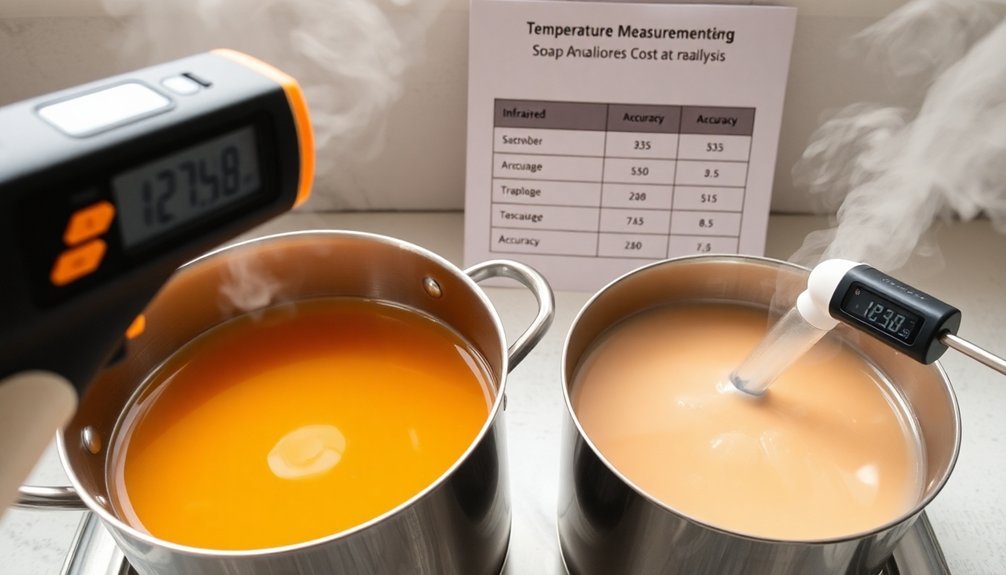
As you evaluate temperature measurement tools for your soap-making operation, understanding the true cost-effectiveness goes beyond just the initial purchase price.
While infrared thermometers like the eT650D may range from $13 to $169, they often prove more economical than purchasing multiple traditional thermometers for different stages.
You'll likely recover this investment quickly through reduced potential soap-making failures. When temperatures are imprecise, batches can fail, wasting expensive oils and lye.
Infrared models provide instant readings across a wider surface area, saving production time and improving efficiency.
Long-term savings further tip the scales in favor of infrared options. They require less maintenance, fewer calibrations, and simpler cleaning procedures.
This thorough value proposition makes infrared thermometers particularly attractive for both hobbyist and commercial soap makers.
Frequently Asked Questions
What Type of Thermometer Is Best for Soap Making?
Infrared thermometers are best for soap making as they offer non-contact readings, prevent contamination, and allow you to safely measure hot oils and lye mixtures from a distance while ensuring accurate temperature monitoring.
Is an Infrared Thermometer Better Than a Regular Thermometer?
Yes, an infrared thermometer is better for you when making soap. You'll appreciate the non-contact measurements, instant readings, and safety benefits while keeping a safe distance from hot oils and lye solutions.
What Is the Disadvantage of an Infrared Thermometer?
Infrared thermometers can't measure internal temperatures, only surfaces. You'll get inaccurate readings from reflective materials, can't measure through glass, and readings are affected by steam or proximity heat buildup.
Why Is a Temperature Probe Better Than a Thermometer?
A temperature probe's better than a thermometer because you'll get real-time internal readings instead of just surface temperatures. You can leave it in for continuous monitoring, ensuring accuracy during critical soap-making phases with faster response times.
In Summary
Switching to infrared thermometers for your soap making gives you immediate, accurate readings without contamination risks. You'll appreciate their precision during critical saponification moments when temperatures must be perfect. They're safer for lye mixtures, more efficient for batch production, and though initially pricier than traditional thermometers, you'll find they're worth the investment through improved consistency and quality in your finished soaps.
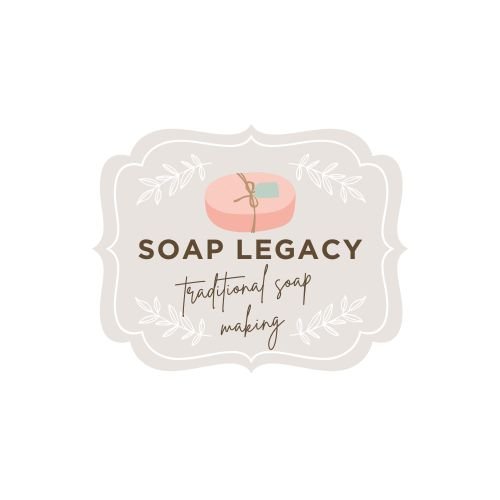




Leave a Reply